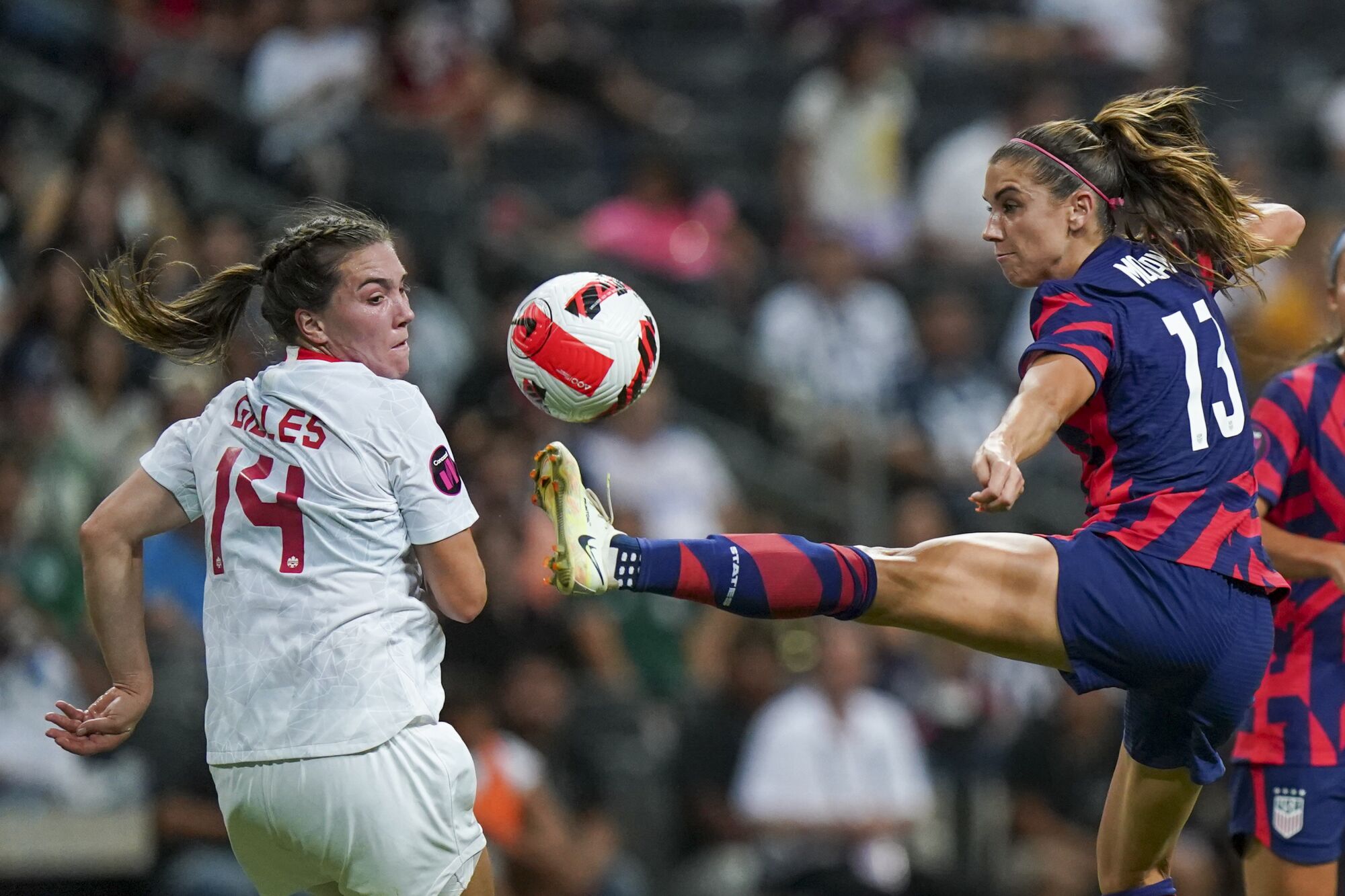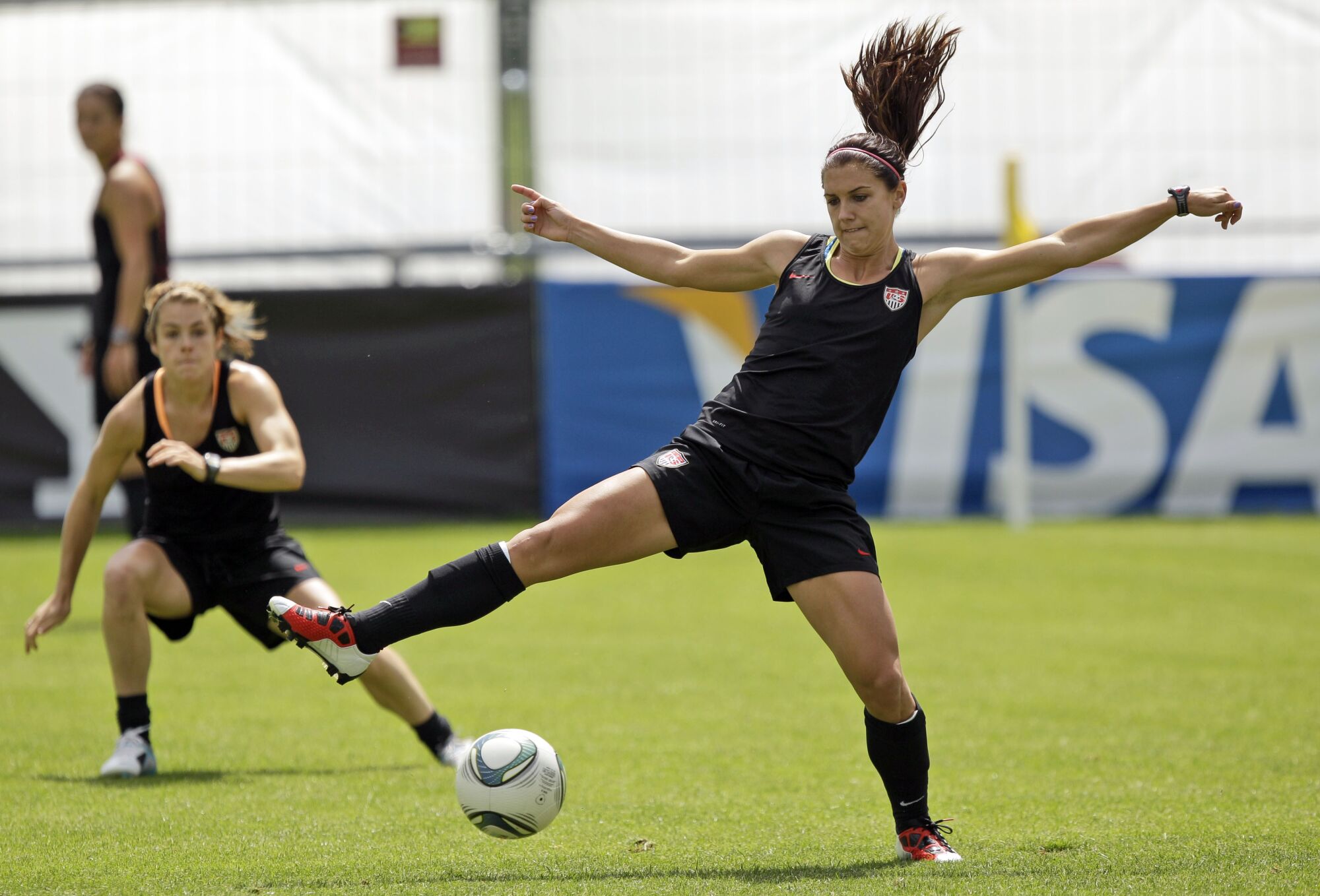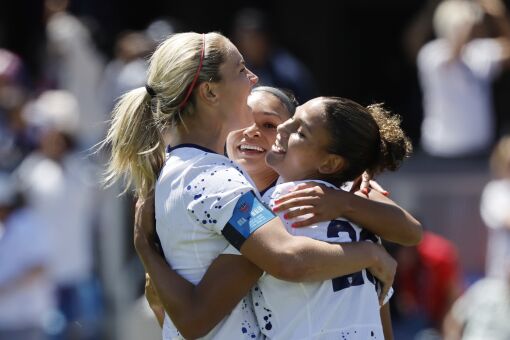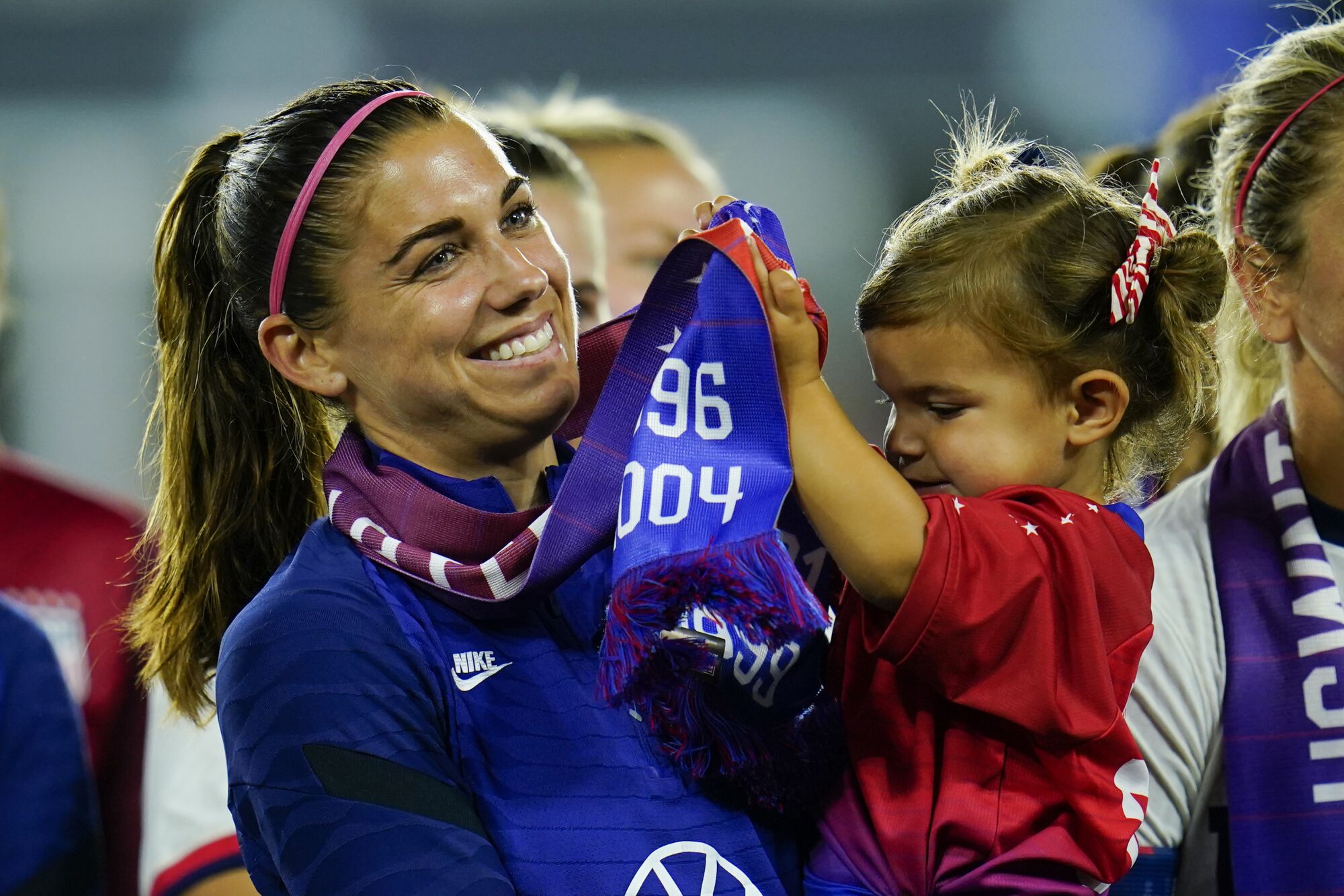How Alex Morgan has grown from soccer’s ‘it girl’ to an American hero chasing history
It’s a scene repeated wherever Alex Morgan goes: tiny girls decked out, like her, in ponytails and a No. 13 national team jersey, and gathered in shrieking crowds in hopes of getting close to their favorite player. It’s difficult to say who gets more from the encounters — the player or her fans.
It happened Sunday after the U.S. women’s soccer team closed preparation for this summer’s World Cup in Australia and New Zealand with a 2-0 win over Wales. Morgan once again was among the last to leave the field, waiting until nearly every autograph had been signed and nearly every selfie had been snapped.
Morgan has long been more the leader of a rock band than a soccer team. Think Taylor Swift (her favorite artist) meets Christian Pulisic. But if she had a somewhat motherly vibe during the scene Sunday, that’s understandable. This World Cup, which kicks off for the Americans on July 22 against Vietnam, will be the fourth and likely last of Morgan’s career. If it ends with the team winning an unprecedented third consecutive title, she will join the debate over who is the most iconic and influential woman in U.S. Soccer history.
Last week she was named co-captain of the U.S. team for a second consecutive World Cup, a nod to her leadership and maturity and the journey that has taken her from precocious AYSO player — whose first coach was her father — to two-time World Cup champion and one of the most recognized athletes in the world.
She was outspoken in the team’s campaigns for gender equality, suing FIFA over its use of artificial turf fields in the 2015 World Cup and serving as the lead plaintiff in the team’s lawsuit against its federation, one that led to a historic agreement between U.S. Soccer and the men’s and women’s teams to pay players equally.
Where once she was U.S. Soccer’s “it girl” — a two-time finalist for world player of the year who was as likely to land on the cover of Sports Illustrated in a swimsuit as in a soccer kit — Morgan, 34, has matured into a two-time selection for Time magazine’s 100 most influential people and a mentor for a team with 14 World Cup rookies.
“With Alex, you’ll get someone that shows up every day, that doesn’t cut corners and sits in the front of the classroom and is typically the last to leave practice. That’s a pro,” said Jill Ellis, who coached Morgan in the World Cup twice and then, as president of the NWSL’s San Diego Wave, made her the foundation of the franchise by acquiring her. “She’s always looking at ways of ‘How can I improve?’ It’s pretty remarkable at this point in her career.”

Alex Morgan, right, controls the ball in front of Canada’s Vanessa Gilles during the CONCACAF Women’s Championship final in July 2022.
(Fernando Llano / Associated Press)
Part of the reason for her late-career renaissance is she no longer is playing for just herself. After the last World Cup, in which she scored a tournament-high six goals, Morgan took a year off to start a family, giving birth in May 2020 to daughter Charlie. When she came back, motherhood, along with the wisdom and experience that come with age, made Morgan a better player.
Last year she tallied the winning goal in the CONCACAF Olympic and World Cup qualifying tournament, in which she was named best player, and scored a career-high 15 goals for the Wave, the first expansion team to reach the NWSL playoffs.
She’s also become more appreciative off the pitch, as relatives helped support her and her daughter.
“It takes a village,” said Morgan’s husband, Servando Carrasco, a former Galaxy midfielder who retired after 10 seasons of professional soccer so his wife could continue playing. “Both [of our] parents made a huge sacrifice to help us out.”
After Charlie was born, Morgan’s parents quarantined for five days each, then flew to Florida to care for the baby as their daughter trained. Carrasco’s mother, Gloria, a two-time cancer survivor, moved to England while the coronavirus raged to care for her 5-month-old granddaughter after Morgan signed with Tottenham of the Women’s Super League.
“The reason that I’m able to do what I do and be who I am is because of my family,” Morgan said. “They’ve lifted me up, they’ve allowed me to chase my dreams. That’s allowed me, since having Charlie, to be more than happy and more than confident in what I have to bring, both on and off the soccer field.
“I try my hardest to be a good mom and I try my hardest to be a great soccer player. And if that’s good enough for me, that’s good enough for my family.”
Family always has nurtured Morgan’s goals, even when they seemed impossible. When she was 7, she left a Post-it note for her mom, telling her she would be a professional soccer player when she grew up.
Her parents responded by driving her to tournaments all over Southern California, never telling her there was no women’s professional league in the U.S.
“They supported my dream,” she said, “even though there was no pathway there.”
But thanks to her hard work and some lucky timing, a path did emerge, one that led to four World Cup appearances, two Olympic medals and an annual income Forbes estimated at $5.7 million in salary and endorsements last year, making her the best-paid women’s soccer player in the world.
“We were just thrilled she was possibly going to get a scholarship,” said Morgan’s father, Mike, who put three girls through college. “It was like, ‘Oh, my God, if she could get something like that, that would be such a plus.’ We weren’t even thinking about the national team.”

Alex Morgan, right, controls the ball next to teammate Kelley O’Hara during a 2011 Women’s World Cup training session in Germany.
(Marcio Jose Sanchez / Associated Press)
When a teen Morgan was being recruited to the University of California, she had a chance encounter that did little to change the course of her career but influenced how she and her father viewed it.
As a sweaty and exhausted Joy Fawcett, who also represented the U.S. four times in the World Cup, was coming off the field, Morgan asked for a picture, except the balky camera wouldn’t work and Morgan needed 10 tries to capture a usable photo.
“She was so patient,” Morgan said. “Those two minutes impacted me so much.”
Her father insisted she too had an obligation to give back, even if it didn’t come naturally.
“She’s grown into this role,” said Mike Morgan, 74, who owned a construction business before retiring in his late 60s. “At first, she was kind of annoyed by it and I would go to her and say, ‘You need to stay out on the field. At least you need to be the last one to go back in.’ And she kind of embraced it. I think she could see what it meant to the girls.”
Fourteen years later, Morgan says her dad won’t mention a poor play or a bad shot after a game. But he will notice what happens when the game is over.

2023 Women’s World Cup coverage
“He’s going to say, ‘You still had fans waiting for you and you walked past them. Why did you do that?’ ” she said. “We both understand what one second of paying attention to someone or signing someone’s autograph, what a big impact such a little piece of time can have.”
Lately, Mike Morgan has had an unlikely ally in that quest: his granddaughter, Charlie, now 3.
“We’ll be walking into the locker room and she’s like ‘Mommy, mommy, there’s someone yelling Alex Morgan’ or she will point and wave,” Morgan said.
That’s not Charlie’s only contribution to team chemistry. She’s already attended more national team games than three players on the World Cup roster, frequently greeting her mother on the field after games and accompanying her to media interviews.
Morgan is just one of a record three soccer moms on the World Cup roster, alongside midfielder Julie Ertz and defender Crystal Dunn, both of whom gave birth in the last 14 months. That’s changed the dynamic around the team.
“It’s been tremendously grounding,” Carrasco said. “As athletes, you chase the next win, you chase the next milestone, whether that’s getting to 200 caps or 100 goals or winning the next World Cup. But then once you get a little mini version of you that’s running around the house, going to games with you, it’s more of a reference why you do what you do.
“The equal pay stuff, all the things the U.S. women’s national team has been fighting for, now there’s someone you can point at and be ‘This is why I’m doing that.’ ”
Despite that, Morgan wasn’t guaranteed a place on the team after giving birth at age 30, which is late middle age for a soccer player. The top-ranked U.S. team is the deepest and most talented in the world, and there was a long line of players willing and able to claim Morgan’s place when she took maternity leave. That’s why she took her trademark ponytail to England to begin her comeback while still breastfeeding.
“She almost had to claw her way back to the national team and come back stronger as a player and a better leader,” Carrasco said. “That’s far from easy to do when you’re almost in the twilight years of your career. But she actually found a way to get better.”

Alex Morgan holds her daughter, Charlie, during an event at Audi Field in Washington in Sept. 2022.
(Julio Cortez / Associated Press)
“I try my hardest to be a good mom and I try my hardest to be a great soccer player. And if that’s good enough for me, that’s good enough for my family.”
— Alex Morgan
Carrasco — who played with Zlatan Ibrahimovic on the Galaxy and Kaká, a former world player of the year, in Orlando — says Morgan’s late-career rise is reminiscent of players who remained effective as they aged.
“She kind of falls into that category in the sense where the older she gets, the smarter she gets,” he said.
Motherhood also has refueled and reenergized Morgan, whose soccer career always had come first. Now soccer is no better than second — and was recently in danger of falling off the list altogether.
“Being a mom, that’s my priority,” she said. “When I decided to have a child, I had been on this team a decade. I had been at peace with what I had done and I decided this is now a new chapter in my career. If this new chapter includes soccer, great. But I’m at peace if it doesn’t.
“When I realized that I had a choice, that’s when it all started to change in my mind.”
With that new mindset, Morgan has scored 42 goals for club and country since giving birth, most by a national team soccer mom. It also has helped her decide what she wants to do after her last game, whether that’s this season or years down the road.
In March, after touring Casa Familiar’s storefront art gallery in San Diego and visiting the community development group’s offices within sight of the Mexican border, Morgan introduced her foundation, which is built around empowering girls and supporting mothers in the kind of hard-scrabble neighborhoods that make up much of South San Diego County.
Morgan said she’s been thinking about a foundation for at least five years, but the combination of becoming a mother and moving to San Diego, where her Mexican-born husband went to high school, brought matters into focus.
“Having a home 12 months out of the year, it’s the first time we’ve got to experience that,” said Morgan, who has played for three clubs in two countries in the last three years. “I wanted to dig in, I wanted to make sure that I give back as much as possible. To girls who lack opportunities, I want to create more for them. For moms who feel alone, I want to create support for them.”
Before the announcement of the foundation, Morgan met behind closed doors with 17 young girls. They drew their chairs into a circle and kept one seat, next to a vase filled with wildflowers, vacant for her. It’s in settings such as these, away from the cameras and the notebooks, where she really shines.

Alex Morgan signs autographs for fans before an international friendly against Wales in San Jose on Sunday.
(Doug Zimmerman / USSF via Getty Images)
At first the shy girls, dressed in blue Alex Morgan Foundation T-shirts, spoke in voices barely above a whisper. Morgan patiently drew them out, however, and answered each question about her career with one of her own about the girls’ lives and struggles. She was no longer Alex Morgan, soccer superstar. Listening more than she talked, she was just another mom concerned about her community and the kids who live there.
Soccer rarely was mentioned.
At one point a girl asked Morgan who her role model was.
“My mother,” she replied, sharing a story about how her mom, Pamela, worked during the day and studied at night yet still found time to ferry her three daughters to softball, soccer and basketball practices. All 17 tiny heads nodded in recognition.
The foundation is in its infancy but its mission statement hints at an aggressive agenda, one that includes identifying “roadblocks” that prevent communities from reaching their potential and investing in “tangible solutions.” Sports, especially soccer, will be a big vehicle in making that happen, Morgan said.
“That’s what I want to spend a lot of time on, not only now but when I retire and really get a chance to be part of this community,” she said.
How soon that retirement comes could be determined by the World Cup, where the U.S. will have to play seven times in 29 days to reach the final. That could prove to be quite a load for Morgan, the team’s only true center-forward whose 34-year-old legs already have carried her through more games than any other player on the roster.
But when the end does come, her place as one of the most iconic players in U.S. Soccer history will be secure. She already ranks in the top 10 in appearances (207) and assists (49) and in the top five in goals (121).
Those numbers are likely to grow with another season left on her contract with the Wave, plus a mutual option for 2025. She would like to play through the Paris Olympics next summer.
Another successful World Cup — Morgan has lost just one game in three previous tournaments — would provide the perfect springboard.
“I do want to win another World Cup. I do want to win other Olympics. I do want to win an NWSL championship,” she said.
But however this World Cup and the rest of her career ends, Morgan always will have her family, her daughter and a legion of tiny, ponytailed fans.
For all the latest Sports News Click Here
For the latest news and updates, follow us on Google News.
